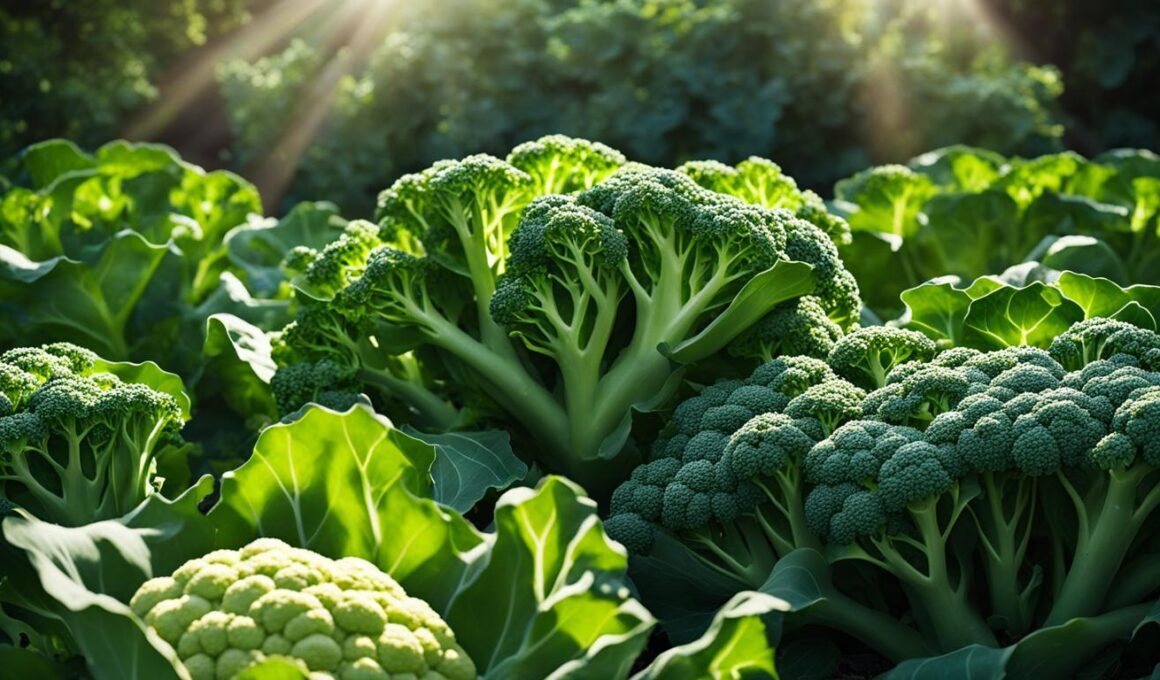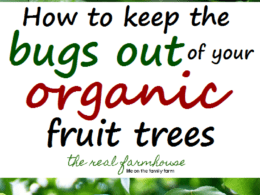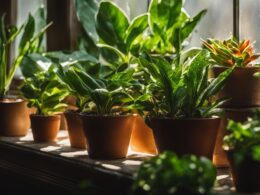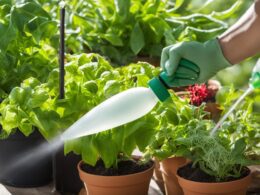Are you ready to take your gardening skills to the next level? Growing broccoli and cauliflower together in your garden is a fantastic way to enjoy the benefits of two nutritious and versatile vegetables. Not only will you have a bountiful harvest, but you’ll also save space and maximize the yield from your garden. In this article, we’ll provide you with valuable tips and advice on how to successfully grow broccoli and cauliflower together.
Post Summary:- Growing broccoli and cauliflower together can save space and maximize your vegetable yield.
- Choosing the right varieties is crucial for successful growth.
- Start broccoli seeds indoors 7 to 9 weeks before the last frost, or sow them outdoors 2 weeks before the last frost.
- Transplant your seedlings in a sunny location with well-drained soil.
- Harvest broccoli when the first flower starts to turn yellow and cauliflower when the heads are compact and firm.
Choosing the Right Varieties
When growing both broccoli and cauliflower together, it’s important to choose the right varieties. Consider the size and color you prefer, as well as the compactness of the plants. Compact types are suitable for limited gardening spaces, while colorful varieties might be appealing to encourage children to eat their vegetables. All broccoli and cauliflower varieties are packed with vitamins and nutrients, so your decision can be based on personal preferences.
| Variety | Description |
|---|---|
| Broccolini | A hybrid variety with smaller florets and long, tender stems. |
| Romanesco | A unique variety with stunning fractal-like heads and a nutty flavor. |
| Purple Sprouting | A colorful variety that produces purple heads and has a long harvest period. |
| Cheddar Cauliflower | A bright orange variety that is rich in beta-carotene and has a mild, sweet flavor. |
By selecting different varieties, you can have a diverse range of flavors and textures in your garden. Experiment with both traditional and unique varieties to add excitement to your harvest.
Finding varieties that suit your taste and growing conditions is key to a successful broccoli and cauliflower garden. Whether you prefer compact plants for small spaces or vibrant colors to make your garden pop, there’s a variety out there for you. Don’t be afraid to try something new and discover the unique flavors and visual appeal that different varieties can bring to your table.
Summary
- Consider the size, color, and compactness of the broccoli and cauliflower varieties.
- Compact types are suitable for limited gardening spaces.
- Colorful varieties can make vegetables more appealing to children.
- Broccoli and cauliflower varieties offer a range of flavors and textures.
- Personal preferences can guide your selection.
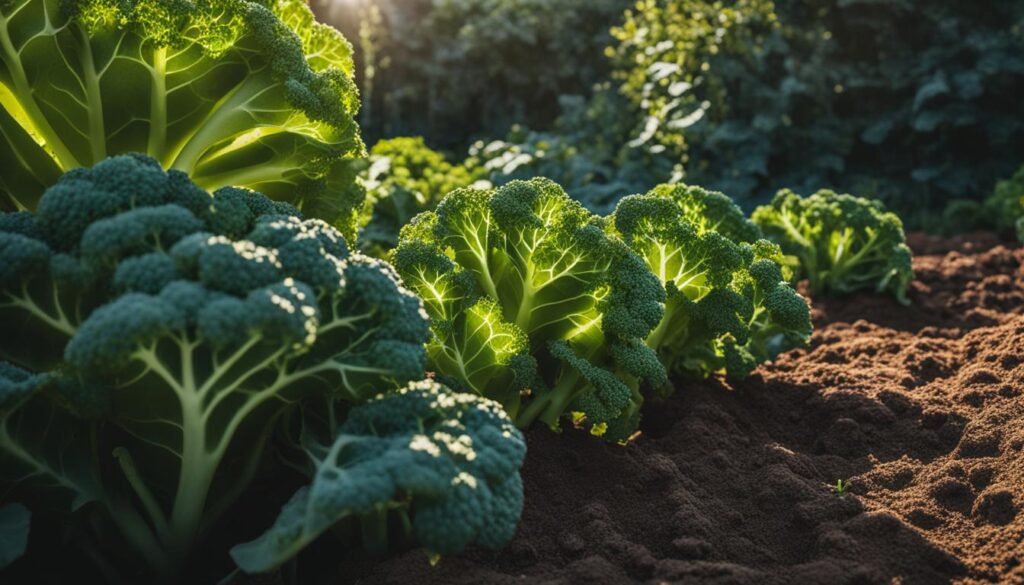
| Plant | Start Indoors | Start Outdoors | Germination Time |
|---|---|---|---|
| Broccoli | 7-9 weeks before last frost | 2 weeks before last frost | 10-14 days |
| Cauliflower | 5-7 weeks before last frost | N/A | 8-10 days |
Starting Broccoli and Cauliflower Seeds
When it comes to starting broccoli and cauliflower seeds, there are a few important factors to consider. The first thing you need to do is sow the seeds at the right depth. It’s recommended to sow the seeds at a depth of 4 times the size of the seed or ½ inch deep. This will ensure that the seeds have enough soil coverage to germinate properly.
After sowing the seeds, it’s crucial to water them thoroughly. The soil should be kept lightly moist throughout the germination process. Be careful not to overwater the seeds, as this can lead to rotting. Providing proper lighting is also essential for healthy seedlings. If you’re using fluorescent lights, make sure to keep them on for 14 to 16 hours a day. If you prefer natural light, place the seedlings near a south-facing window for ample sunlight.
It’s important to note that broccoli generally takes around 45 to 60 days to grow from sowing to harvest, while cauliflower can take anywhere from 30 to 80 days. Keeping track of the growth period will help you plan and anticipate when your plants will be ready for harvest.
Key Points:
- Sow broccoli and cauliflower seeds at a depth of 4 times the size of the seed or ½ inch deep.
- Thoroughly water the seeds and keep the soil lightly moist.
- Provide ample lighting, either through fluorescent lights or natural sunlight near a south-facing window.
- Broccoli takes around 45 to 60 days to grow, while cauliflower can take 30 to 80 days.
Transplanting Broccoli and Cauliflower Seedlings
Once your broccoli and cauliflower seedlings have developed at least two sets of true leaves, they are ready to be transplanted into your garden. This typically occurs about 2 weeks before the last frost date in your area. Transplanting them at the right time is crucial for their successful growth and maturity.
When choosing a location for transplanting, ensure it receives full sun for optimal growth. The soil should be well-drained and rich in organic matter to provide the necessary nutrients for healthy development. If needed, prepare the soil by adding compost or well-rotted manure before transplanting.
When transplanting, space the broccoli and cauliflower plants 18 to 24 inches apart in rows that are 2½ to 3 feet apart. This spacing allows them enough room to grow and prevents competition for nutrients and sunlight. Use a garden trowel to dig holes that are slightly larger than the root ball of the seedling. Gently remove the seedling from its container, being careful not to damage the roots, and place it into the hole. Backfill the hole with soil, firming it gently around the base of the seedling to ensure good contact.
| Spacing | Fertilizing | |
|---|---|---|
| Broccoli | 18-24 inches apart | First planting: Low-nitrogen fertilizer When 6-8 inches tall When buds form |
| Cauliflower | 18-24 inches apart | Every 4 weeks |
After transplanting, water the seedlings thoroughly to settle the soil around the roots. Ensure that the soil remains consistently moist, but not waterlogged, during the early stages of growth. Utilize mulch around the plants to help retain moisture and deter weed growth.
Throughout the growth of your broccoli and cauliflower, regular fertilization is essential. Apply a low-nitrogen fertilizer when first planting the seedlings, and continue fertilizing them according to the recommended intervals for each vegetable. Broccoli should be fertilized again when the plants are 6 to 8 inches tall, and once more when the buds first start to form. For cauliflower, fertilize every 4 weeks to support healthy development.
Special Considerations and Growing Tips
When growing broccoli and cauliflower, it’s important to be aware of some common problems that may arise. One issue specific to cauliflower is “buttoning,” which refers to the premature formation of small heads or flowers. This can occur if the seedlings have been held for too long or if they have experienced unfavorable growing conditions. To prevent buttoning, ensure that your cauliflower seedlings are transplanted at the right time and avoid subjecting them to stress.
Another challenge you may encounter is extreme cold or drought, which can affect the growth of both broccoli and cauliflower. It’s crucial to provide consistent watering, especially during dry periods, and to protect your plants from frost or extreme temperatures. Mulching around the base of the plants can help retain moisture and regulate temperature.
“Cauliflower is like broccoli with a college education. It has a more delicate flavor, but it’s just as nutritious.” – Linda Arndt
Companion planting can also be beneficial when growing broccoli and cauliflower. Beets, onions, and garlic are good companions for both vegetables. Beets help repel pests like aphids and provide shade for the shallow-rooted cauliflower. Onions and garlic deter pests and some diseases that can affect broccoli and cauliflower. Additionally, herbs like dill and chamomile can attract beneficial insects that prey on pests.
Table:
| Broccoli | Cauliflower | |
|---|---|---|
| Common Problems |
|
|
| Companion Plants |
|
|
| Harvest Time | 60-90 days | 50-80 days |
By being aware of these problems and implementing preventive measures, you can increase the chances of a successful broccoli and cauliflower harvest. Remember to monitor your plants regularly, practice good garden hygiene, and provide the necessary care to keep them healthy and thriving.
Harvesting and Storing Broccoli and Cauliflower
Once your broccoli and cauliflower plants have reached the appropriate stage of maturity, it’s time to harvest and store your homegrown vegetables. Harvesting broccoli is best done when the first flower starts to turn yellow and the buds are firm and tight. Use a sharp knife or shears to cut the central head along with 5 or 6 inches of stem, as this will stimulate the growth of side shoots for continuous harvest. Remember to leave some foliage on the plant to allow it to continue growing.
After harvesting, it’s important to handle broccoli with care to prevent rot in the stems. Trim the bottom of the stem diagonally and place the heads in a container of cool water to remove any dirt or debris. Once clean, allow the broccoli to air dry before storing.
To best store fresh broccoli, place it in a perforated plastic bag or wrap it loosely in a damp paper towel. Store the unwashed broccoli in the refrigerator’s crisper drawer at a temperature of 32-36°F (0-2°C) for 3 to 5 days. Proper storage will help maintain the freshness and crispness of the vegetable.
When it comes to harvesting cauliflower, wait until the heads are compact and firm, measuring about 6 to 8 inches in diameter. If the heads begin to open and flower, it means they have over-matured and the quality may be compromised. Use a sharp knife to cut the cauliflower heads from the plant, making sure to leave some of the outer leaves intact to protect the head.
To store unwashed cauliflower, place it in a paper or plastic bag and make sure to seal it tightly to retain moisture. Store the cauliflower in the refrigerator’s crisper drawer at a temperature of 32-36°F (0-2°C). Uncooked cauliflower can be stored for up to a week, but it’s best to consume it as soon as possible for optimal freshness.
By following these harvesting and storage tips, you can enjoy the flavors and nutritional benefits of freshly harvested broccoli and cauliflower for an extended period of time. Remember to handle the vegetables with care, clean them properly, and store them in the right conditions to maintain their quality and taste.
| Vegetable | Harvesting | Storage |
|---|---|---|
| Broccoli | Harvest when first flower turns yellow and buds are firm and tight. Cut central head with 5-6 inches of stem. | Place in perforated plastic bag or wrap loosely in damp paper towel. Store in refrigerator’s crisper for 3-5 days. |
| Cauliflower | Harvest when heads are compact and firm, measuring 6-8 inches in diameter. | Place in paper or plastic bag and seal tightly. Store in refrigerator’s crisper for up to a week. |
Can Broccoli and Cauliflower Be Grown Together in the Same Garden?
Broccoli and cauliflower can indeed be grown together in the same garden. However, to maximize space and yield, you can also consider employing a gardening technique called companion planting. For instance, you can grow corn and beans together with these cruciferous vegetables. Corn provides support for the beans, which in turn fix nitrogen into the soil, benefiting all the plants in the vicinity. This symbiotic relationship promotes healthy growth while optimizing space in your garden.
Conclusion
Growing broccoli and cauliflower together in your garden can be a rewarding and enjoyable experience. By following a few simple tips, you can ensure a successful harvest of these delicious and nutritious vegetables.
Firstly, choosing the right varieties is essential. Consider your preferences for size, color, and compactness when selecting broccoli and cauliflower plants. Remember that all varieties are packed with vitamins and nutrients, so choose based on personal preferences.
Timing is also crucial when starting your broccoli and cauliflower. Starting seeds at the right time will give them enough time to mature before extreme temperatures or frost. Be sure to sow them at the proper depth, provide adequate lighting, and maintain proper care throughout their growth.
Finally, when it’s time to harvest, remember to cut broccoli when the flower starts to turn yellow and the buds are firm and tight. Store fresh broccoli in the refrigerator’s crisper for optimal freshness. For cauliflower, harvest when the heads are compact and firm, and store uncooked cauliflower in the refrigerator for up to a week.
With these tips in mind, you can enjoy the satisfaction of growing your own fresh vegetables and have an abundant supply of broccoli and cauliflower to enjoy in your meals. So get started today and witness the joy of growing these versatile vegetables in your garden.
Can I Grow Broccoli and Cauliflower Together in the Same Garden Bed?
Yes, you can grow broccoli and cauliflower together in the same garden bed. Both are cool-season crops that have similar soil and water requirements. However, be mindful of the spacing between plants to ensure proper air circulation and sunlight. Consider companion planting, such as growing kale and dill together, to promote healthy growth and deter pests.
FAQ
What varieties of broccoli and cauliflower should I choose?
When choosing varieties, consider the size, color, and compactness you prefer. All varieties are nutritious, so your decision can be based on personal preferences.
When should I start broccoli and cauliflower seeds?
Start broccoli seeds indoors 7 to 9 weeks before the last frost or outdoors 2 weeks before. Start cauliflower seeds indoors 5 to 7 weeks before the last frost.
How deep should I sow broccoli and cauliflower seeds?
Sow the seeds at a depth of 4 times their size or ½ inch deep.
What lighting do broccoli and cauliflower seedlings need?
Provide seedlings with 14 to 16 hours of fluorescent light per day or place them near a south-facing window for natural light.
When can I transplant broccoli and cauliflower seedlings?
Once your seedlings have at least two true leaves, they are ready to be transplanted, typically about 2 weeks before the last frost.
How should I fertilize broccoli and cauliflower?
Use a low-nitrogen fertilizer when first planting and continue fertilizing every 4 weeks. Broccoli should also be fertilized when the plants are 6 to 8 inches tall, 12 to 15 inches tall, and when buds first form.
What are some special considerations for growing broccoli and cauliflower?
If seedlings are held too long or mistreated, they may develop small heads called “buttons.” Extreme cold or drought can also affect growth. Beets, onions, and garlic are good companion plants.
When should I harvest broccoli and cauliflower?
Harvest broccoli when the first flower turns yellow and the buds are firm and tight. Cut the central head along with 5 or 6 inches of stem. Harvest cauliflower when the heads are compact and firm, about 6 to 8 inches in diameter.
How should I store broccoli and cauliflower?
Store fresh, unwashed broccoli in the refrigerator’s crisper for 3 to 5 days. Store uncooked cauliflower in a paper or plastic bag in the refrigerator for up to a week.





